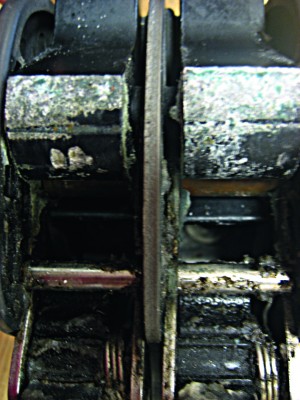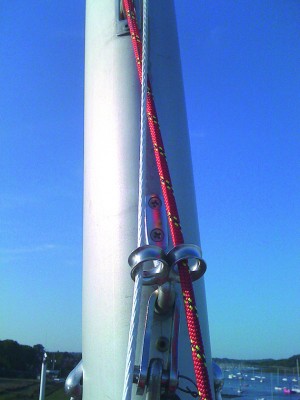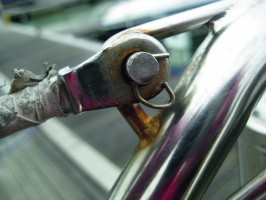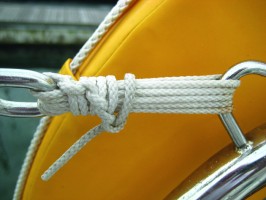Taking a good look at your deck gear can turn up a surprising number of problems. Matthew Sheahan asks two rigging experts for their top tips on the early season checkover
You may have stepped off the boat at the end of the autumn series with a mental list of items that needed attending to over the winter, but how many of them were actually addressed? Even if you got on with the job list, a winter at rest ashore or afloat can store up new problems for the coming season.
Gordon Bonney of Hamble-based Performance Rigging believes that many of the early season niggles and breakdowns are easily avoided simply by taking a look at the state of your rigging and deck gear.
“While you may need some expert help in fixing a problem later, it doesn’t always take an expert to spot potential problems, just time,” he says. “Most people would be amazed at how simple and how common many of the maintenance issues are. We can walk around a typical marina with a list of 20 basic items and I can guarantee every boat will have a least one of them. And yet at around £100, a rig check will cost a fraction of just one high-tech halyard.”
Many of the maintenance issues are just common sense, but modern materials and advanced deck gear have been introducing new, less obvious issues.
Spinlock’s Chris Hill explains: “Most people don’t see clutches as having moving parts when under load. But when they’re working properly it is as if they are breathing. You can see this if you watch a clutch carefully as you go through a tack – the cam will move and respond to the changing load on the rope. This movement is essential for the clutch to work efficiently and hold onto the rope.
“If the components don’t move, then the rope can be loaded incorrectly, with the possibility of slip and then chafe as a result. Bearings can also be damaged over time, which can exacerbate the problem. And all because the clutch components were fouled up.”
Most of us will have experienced slipping halyards and lines and will doubtless have assumed that the clutch was wearing out, but the solution can often be a simple case of cleaning the workings.
As any top team will confirm, preparation is a major part of any campaign and getting a season off to a good start begins with taking a careful look at your kit.
Here are five key areas to look at that the experts come across frequently.
1. Twisted or chafing halyards
They might have been fine in the autumn when you last raced, but if the halyards were not taken out of the mast and replaced with mouse lines there’s a good chance they will have chafed over the winter.
Whether the halyards were accidentally twisted around each other or were simply lying over the top of the forestay or behind a spreader, a few months sitting in the same position and flapping in the breeze is enough to cause problems.
Ideally you should attach mouse lines and take each halyard out to inspect it. Alternatively, hoist each one fully with a spare line attached to haul it back down, so that you can inspect the complete length of halyard, including the section that runs inside the mast. When the halyard is fully up, take particular note of areas where it runs through a fairlead, round a block or through a jammer and onto the winch. Remember that different headsails and mainsail reefing points will result in multiple potential areas for chafe.
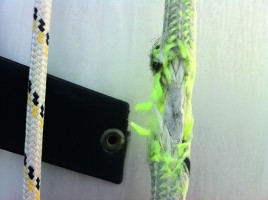 If you do find any chafe, make sure you identify what is causing it. Forestay split pins and spinnaker halyard spectacles are common culprits.
If you do find any chafe, make sure you identify what is causing it. Forestay split pins and spinnaker halyard spectacles are common culprits.
Many modern high-performance ropes are susceptible to UV degradation. If they’ve been left out over the winter they need to be checked carefully and possibly replaced.
2. Clutch cleaning
Salt deposits and corrosion can make clutches stiff to operate and less efficient, but a build-up of fluff and debris inside a rope clutch is a less well-known problem that can halve a clutch’s holding capacity.
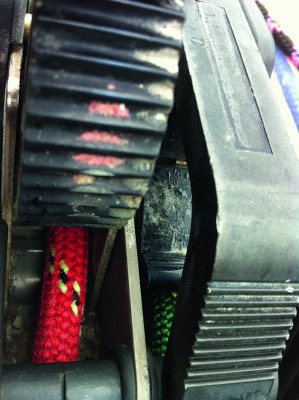 Unlike traditional, large-diameter polyester ropes, modern ropes are often treated with coatings that are gradually shed in the clutch. Boat ropes also pick up general debris along the deck and draw it into the unit, so there is usually plenty to clean out.
Unlike traditional, large-diameter polyester ropes, modern ropes are often treated with coatings that are gradually shed in the clutch. Boat ropes also pick up general debris along the deck and draw it into the unit, so there is usually plenty to clean out.
Washing the clutch with fresh water and using a toothbrush should remove much of the debris. The base area is particularly important.
Acetone is good for degreasing grip surfaces, but try to keep it away from plastic surfaces. Never use WD40 as a lubricant on clutches as it dries out and damages plastic components. Silicon or Teflon-based lubricants such as McLube are preferred.
3. Finding the weak link
A number of breakdowns can be avoided simply by taking a careful look at your deck gear, from free-running blocks to stiff jammers, missing split pins or rings, along with checks for cracks in key areas.
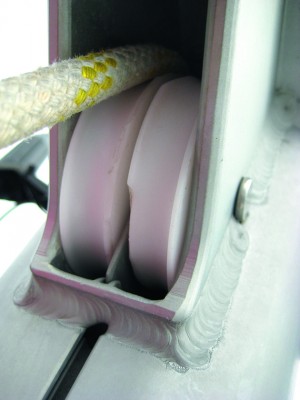 Run through the systems and control lines one by one, tracing from one end to the other and checking for any sign of damage, including worn or bent shackles and clevis pins. Check for cracks around the kicker and mainsheet attachments on the boom.
Run through the systems and control lines one by one, tracing from one end to the other and checking for any sign of damage, including worn or bent shackles and clevis pins. Check for cracks around the kicker and mainsheet attachments on the boom.
Simply lifting the luff groove at the lower end of the forestay at the bow can often indicate whether there is a problem at the top. The foil should rise by only a few centimetres – any more and the top spacer may be broken, which could cause problems with hoisting or lowering headsails. Also check for damage to the groove.
Replace cable ties that have been used to lock shackles as the plastic degrades in UV.
4. Fasten up your fastenings
“Running through the boat and checking all fastenings, shackles, screws, rivets and split pins is a simple task often overlooked,” says Gordon Bonney. “Rivets and fastenings that don’t sit flat should be treated with suspicion.”
 Open-bodied rigging screws on rod rigging that have been supposedly locked together with a strap linking the bodies are another of Bonney’s concerns: “While the body is prevented from turning, the rod rigging can rotate in its collar and unwind from the top of the rigging screw when it is on the leeward side and unloaded.”
Open-bodied rigging screws on rod rigging that have been supposedly locked together with a strap linking the bodies are another of Bonney’s concerns: “While the body is prevented from turning, the rod rigging can rotate in its collar and unwind from the top of the rigging screw when it is on the leeward side and unloaded.”
Deck chocks for keel-stepped masts are often neglected, allowing the mast to move in the deck ring. Apart from making it impossible to keep the rig in tune, movement here can cause impact on the mast wall and inflict serious damage.
For pre-season prep you need spare pins, shackles and split rings, insulation tape, silicon to cover split pins and Loctite.
5. Guardwires and jackstays – keep safe
Guardwires may be static devices, but with an entire crew hanging off them as they hike upwind, their contribution to boat speed shouldn’t be underestimated.
Losing your crew over the side is not good, but you might be surprised at just how many boats are close to losing theirs because of poor maintenance.
“Guardwire lashings that have come undone, or guardwire attachments that are not locked off – you’d be shocked at how common this is,” says Bonney. “We see spilt pins missing at least once a week, every week.”
Jackstays are also often neglected. Left in place over winter and at the mercy of further UV degradation following a season of chafe underfoot, they can be damaged. The webbing/wire and its attachments should be checked and replaced. There is absolutely no excuse to skimp here; you and your crew depend on these items.





